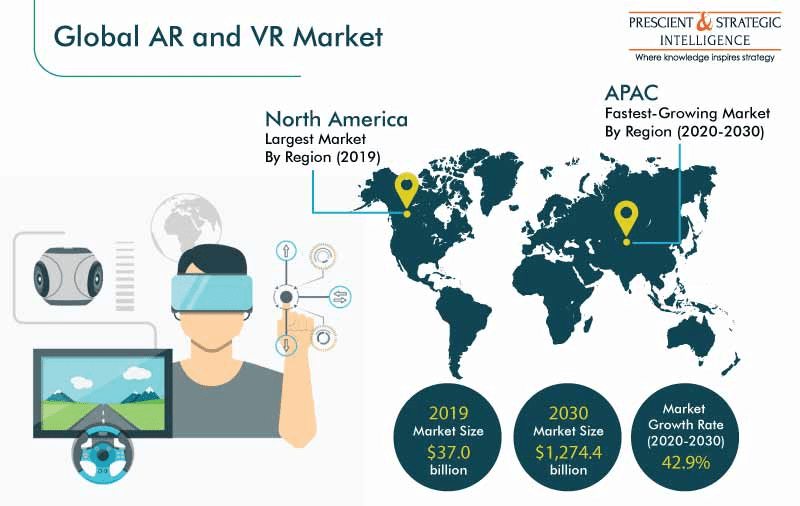Augmented reality and virtual reality are two emerging technologies with mounting business and consumer applications in the wake of the COVID-19 pandemic.
AR refers to the addition of digital elements to a live, real-world environment and has been made popular through Snapchat filters and games like Pokemon Go, while VR operates through entirely simulated environments on a completely different platform that’s entirely separate from the real world.

(Image: PSI)
While both AR and VR have gained traction in the field of entertainment over recent years, after a transformative COVID-19 pandemic that’s introduced much of the world to remote work, we may see reality technology developing in more business-oriented use cases. As the chart above shows, the AR and VR market will rapidly accelerate into a trillion-dollar industry by 2030 at an annual growth rate of 42.9%.
There are already mounting use cases forming across the industry for both augmented reality and virtual reality offering assistance in expediting front-end HR processes like recruiting and employee onboarding. The adaptation of reality technology for HR may not yet have become mainstream, but its potential is clear for a world that’s becoming increasingly remote.
Virtual Gamification in Recruitment
One of the biggest challenges HR professionals face revolves around recruiting new employees that may never set foot in their employer’s office, and who no staff will ever physically meet.
This entirely digital recruitment process presents new challenges to companies that may have had to undergo a swift digital transformation in the wake of the COVID-19 pandemic. The hardest part of this new approach to recruitment is finding the right candidate for a job without ever meeting them.
Here, virtual reality can help HR departments to find employees in a much more immersive way, helping them to rely on more comprehensive metrics than just the interview process.
VR has the ability to simulate lifelike experiences for applicants, where a difficult customer scenario could be rendered on a shop floor, or a WFH incident occurs that needs to be quickly dealt with. This technology offers employers the chance to see how candidates react in ‘almost’ real-life scenarios – helping to create a much clearer view of each applicant and their merits for the job.
One particularly immersive use case for virtual reality assessments for job candidates can be found in a program used by Accenture. The company has developed a program that can be accessed via VR headsets where candidates are immersed into an Ancient Egyptian crypt and asked to solve a range of hieroglyphics. The exercise has been created to spot whether candidates have the potential to become software programmers.
“Some candidates have the skills by virtue of their academic background. And lots of candidates may not have the skills yet, but they have the aptitude,” explained Adrian Love, UK and Ireland recruitment director for Accenture. “One of my favorite pieces of feedback was from a dyslexic candidate who said that because we chose this narrative storytelling approach, it enabled them to shine in a way other assessment processes with other organizations hadn’t, so [the technology] further supports diversity.”
Love’s comments indicate that Accenture’s VR assessments may help to level the playing field between applicants who may not have the ability to interview as well as others. There’s also evidence that the adoption of the technology was mutually beneficial as Accenture was found to attract more graduate applications in 2019 due to the more engaging screening process.
Although the use of virtual reality hardware makes this form of recruitment more difficult for applicants who won’t have access to the relevant headsets when being remotely recruited for work from home roles, the advancement of this technology will make VR, and particularly AR hardware more accessible over the coming years.
With industry giants like Apple, Facebook and Niantic developing augmented reality glasses with release dates earmarked for 2022 and 2023 respectively, and an eyewear market set to surpass $200 billion dollars in the US over the coming years, it’s likely that adoption rates over the coming decade will help more businesses to develop remote HR applications to better vet applicants.
Immersive Collaboration
Facebook has been a big believer in both AR and VR technology and its application for training and collaboration purposes.
According to the social media giant, AR and VR can help to facilitate training in two broad areas: the functioning, learning and perfecting of skills in hard to replicate scenarios, and the development of soft skills like empathy and conversational competence.
“Collaboration reaches across many experiences, but with VR, people can share spaces and accomplish tasks just like they might in the same room with software and virtual meeting rooms powered by companies like Spatial, Arthur Digital, Iris VR and Insite,” the company states.
Facebook’s interpretation of AR use cases is echoed by Arthur Digital, a platform focused on solving collaboration issues in digital meeting environments in a way that stays true to real-life face-to-face meetings. Based on their VR platform, Arthur Digital has stated that 80% of its clients say that their communication has improved through VR, that 75% of clients believe they work effectively and achieve their goals in VR and that there’s been a 204% growth in meeting participants among clients as well as a 242% increase in the number of meetings taking place.
Such stats indicate that Arthur Digital’s virtual reality technology may offer an insight into the future of successful online meetings in a more remote working environment.
Optimising Remote Performance
Finally, augmented reality has the potential to change the way new recruits are onboarded into companies. In many companies, both in remote or complex environments where either employees working from home are unable to access effective true-to-life training, or workers can’t train effectively because of safety concerns, AR can help users to learn and practice as they wish to minimize the risk of errors during real tasks.
One existing example of this can be found in Boeing’s AR guidance and instruction programs for aircraft technicians. Because there’s such a small margin for error when it comes to aircraft, it’s imperative that employees know their jobs well before they get to work. Through the use of augmented reality, Boeing saw a 25% reduction in production time and a 40% increase in productivity with lower error rates among workers.
Boeing’s example can be adapted for businesses looking to recruit employees in more remote roles. Through the use of AR or VR enabled devices, employees can be onboarded through the use of immersive programs that replicate extreme scenarios to ensure that staff will learn their tasks in an engaging way while reducing instances of error within the job.
As the world emerges from the confines of the COVID-19 pandemic, we’re likely to see a widespread step towards digital transformation for companies as remote work and new technologies are utilized around the world. At the forefront of these innovations will be augmented reality and virtual reality technology. With a deeply engaging digital experience for workers and candidates alike, HR may fundamentally change forever.


